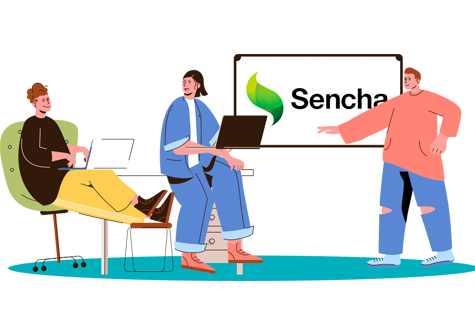Building Beautiful UIs with Sencha for Beginners
The perfect starting point for developers eager to craft visually stunning and user-friendly applications using the Sencha framework. This guide walks you through the fundamentals of Ext JS, covering essential concepts like UI components, layouts, and themes. Whether you're building a simple web app or preparing to dive into complex enterprise projects, this resource equips you with the skills to design responsive, dynamic interfaces. With step-by-step examples, practical tips, and hands-on exercises, you'll quickly master the tools and techniques needed to bring your UI ideas to life, all while embracing industry best practices for front-end development.
Introduction to Sencha
Sencha is a leading framework for building cross-platform applications with a strong focus on performance and scalability. Known for its flagship product, Ext JS, Sencha offers developers a powerful toolkit for creating responsive and dynamic user interfaces for web, mobile, and desktop applications.
Sencha app development services refer to professional services offered by developers or companies to create robust, scalable, and feature-rich applications using Sencha’s frameworks and tools, particularly Sencha Ext JS. These services are often sought by businesses looking to develop web applications with complex user interfaces and high-performance requirements.
Key Components of Sencha
- Ext JS: The main JavaScript framework for building feature-rich web applications with pre-built UI components.
- Sencha Architect: A visual application builder that allows developers to design applications via drag-and-drop functionality.
- Sencha CMD: A command-line tool for scaffolding, building, and deploying applications.
- Sencha Test:: A testing solution for end-to-end testing of Ext JS applications.
- Sencha Themer: A tool for customizing themes and styles of Ext JS applications without writing complex CSS.

Why Choose Sencha for App Development?
Sencha app development services focus on creating robust, feature-rich, and scalable web applications tailored to the needs of businesses. Leveraging Sencha's powerful tools like Ext JS and Sencha Architect, these services help build responsive applications for both desktop and mobile platforms. Developers utilize a wide range of pre-built UI components, including grids, charts, forms, and menus, to deliver user-friendly interfaces with seamless performance. The use of MVC/MVVM architecture ensures well-structured and maintainable code, making applications easy to scale and adapt to evolving business requirements.

- Rich UI Components: Sencha provides a vast library of ready-to-use UI components, including grids, charts, forms, and buttons, ensuring a professional and consistent look.
- Cross-Platform Development: Build applications that work seamlessly across devices and platforms with minimal code adjustments.
- High Performance: Optimized for handling large datasets and complex enterprise applications.
- Robust MVC/MVVM Architecture: Ensures code maintainability and scalability for growing projects.
- Extensive Theming Options: Customize the look and feel of your application to align with your brand.
Our Development Process
Discovery
Design
Deployment and Support
Agile Development
Quality Assurance
Features and Benefits
- Rich UI Components: Ext JS offers a wide array of pre-built components like grids, forms, charts, and trees, making it easier to create complex applications quickly.
- Cross-Browser Compatibility: Applications built with Sencha work seamlessly across all modern browsers.
- Mobile and Desktop Support: The framework supports both mobile and desktop platforms, allowing developers to create responsive designs.
- MVC/MVVM Architecture: Sencha adopts architectural patterns like Model-View-Controller (MVC) and Model-View-ViewModel (MVVM) for organized and scalable codebases.
- Data Integration: Tools for managing and binding data are included, making it easy to integrate applications with APIs or databases.
- High Performance: Designed for large datasets and intensive applications, Sencha optimizes performance with efficient rendering and data handling.

FAQ's
Frequently Asked Questions
Sencha is a robust framework for building data-intensive, high-performance web applications, particularly for enterprise use. It offers pre-built UI components like grids, charts, and forms, which help accelerate development and ensure consistency. Its ability to support cross-platform applications and handle large datasets makes it ideal for businesses requiring scalable and responsive solutions.
Sencha is versatile and can be used to create:
- Enterprise-grade web applications
- Interactive dashboards
- Data visualization tools
- Business intelligence platforms
- Mobile-friendly applications
Whether it’s a financial dashboard, a healthcare management system, or a retail analytics platform, Sencha is suitable for data-rich applications across various industries.
Sencha frameworks, like Ext JS, are designed to work seamlessly across all modern web browsers and devices. Developers use responsive design principles and touch-enabled components to ensure applications function consistently on desktops, tablets, and mobile devices, offering a unified experience for users.
The development timeline depends on the complexity and scope of your project. Small to medium applications can take a few weeks, while more complex, enterprise-grade solutions may require several months. Using pre-built UI components and structured architectural patterns in Sencha often accelerates development compared to other frameworks.
Yes, Sencha is designed with integration in mind. It provides robust tools for handling data binding and working with RESTful APIs or other backend systems. Our development services include seamless integration with your existing systems, databases, and third-party tools, ensuring a smooth workflow and enhanced functionality.
